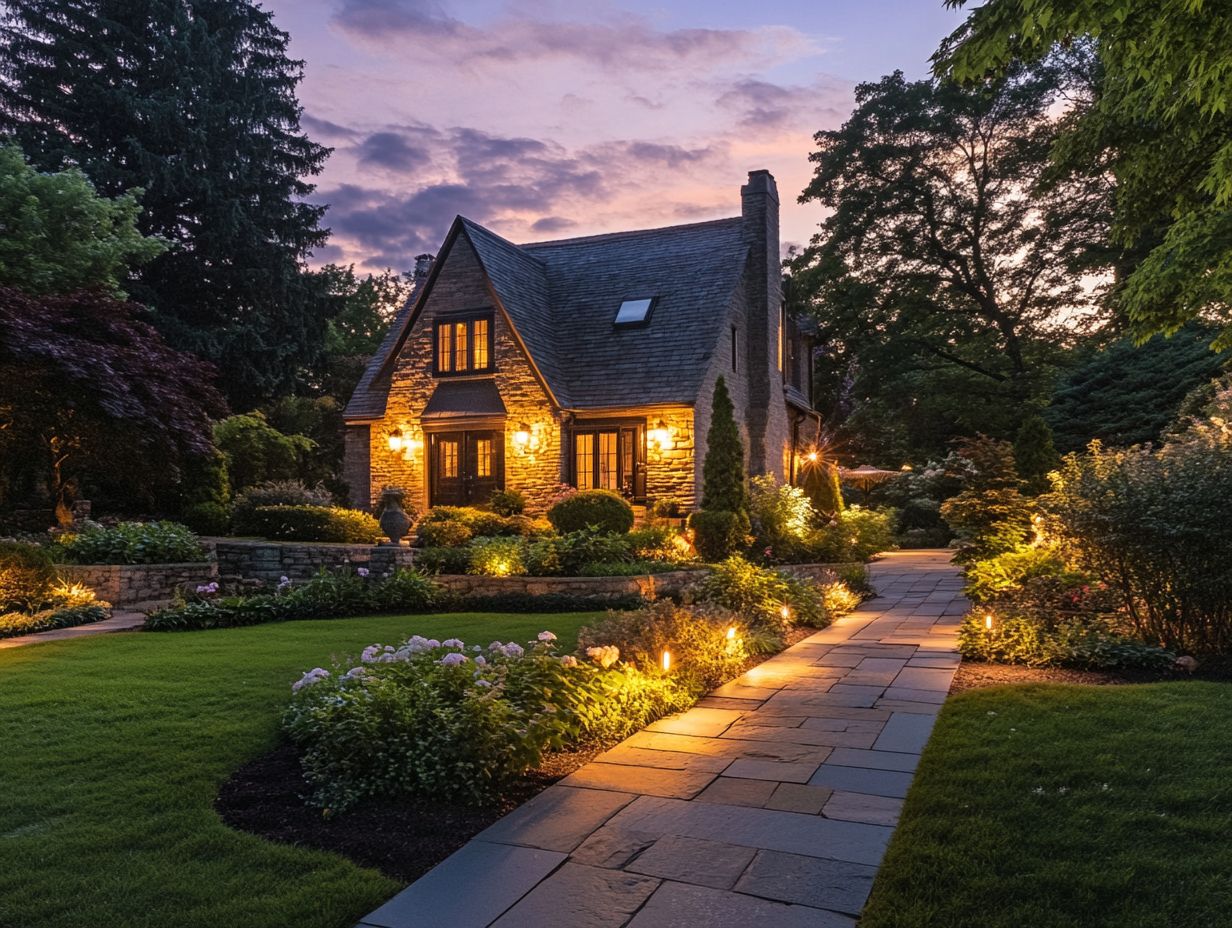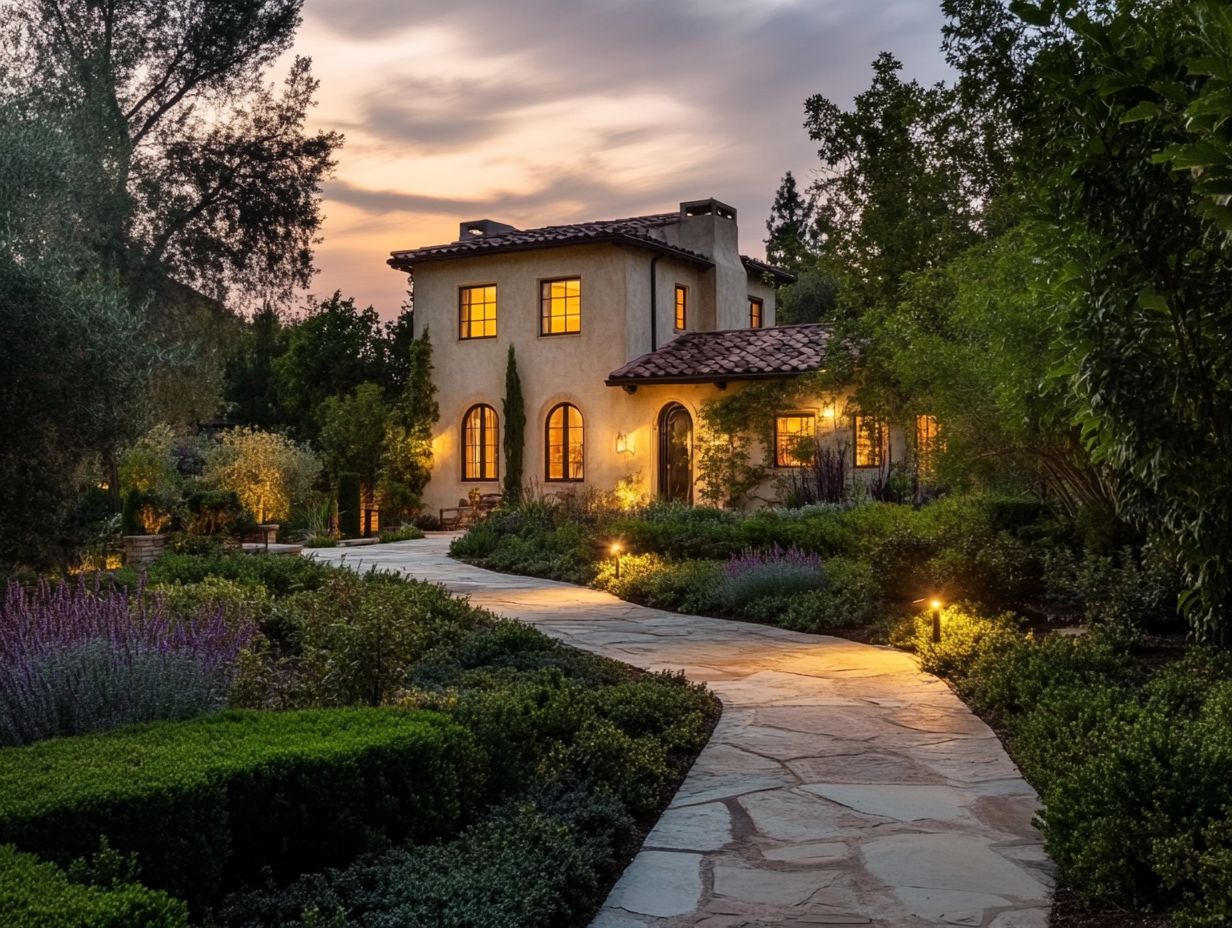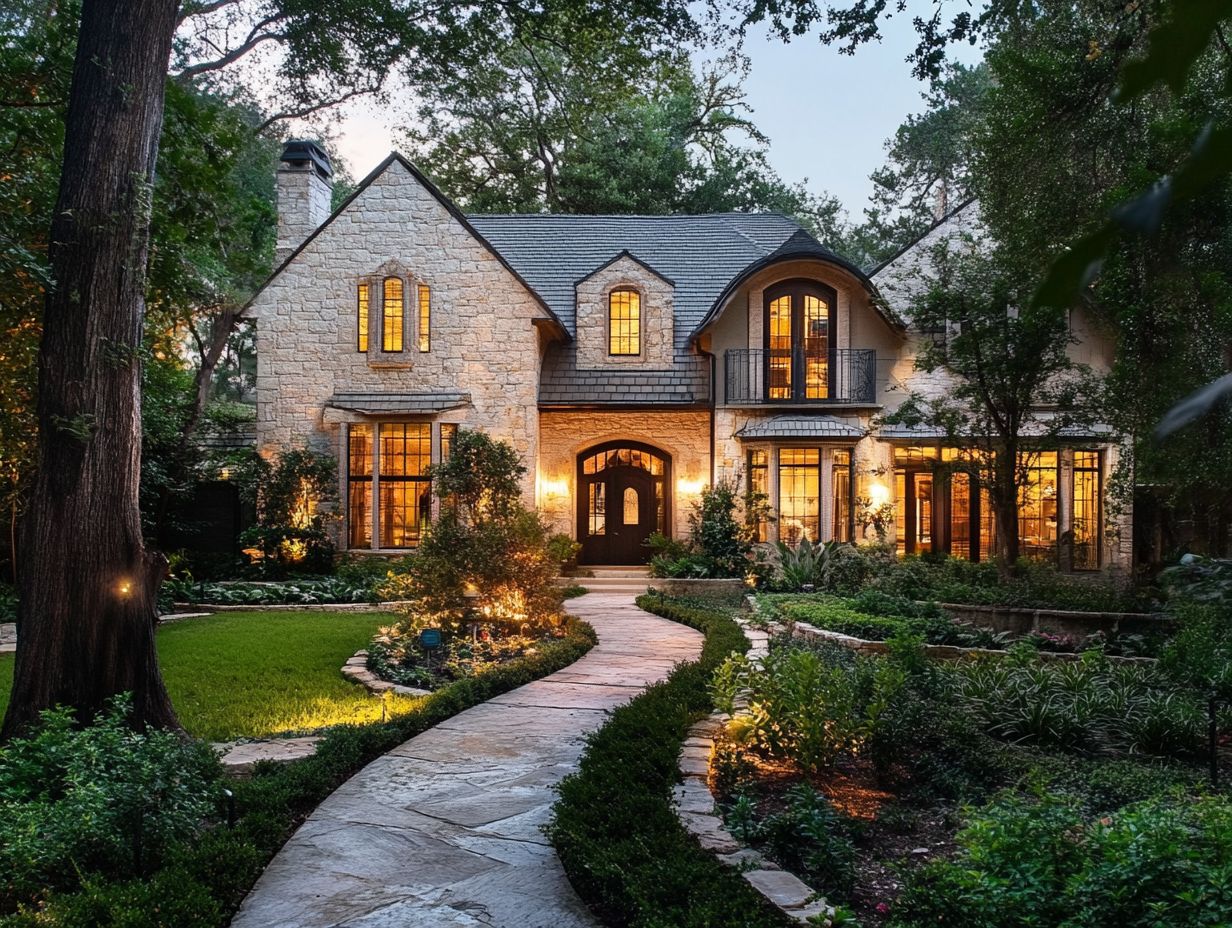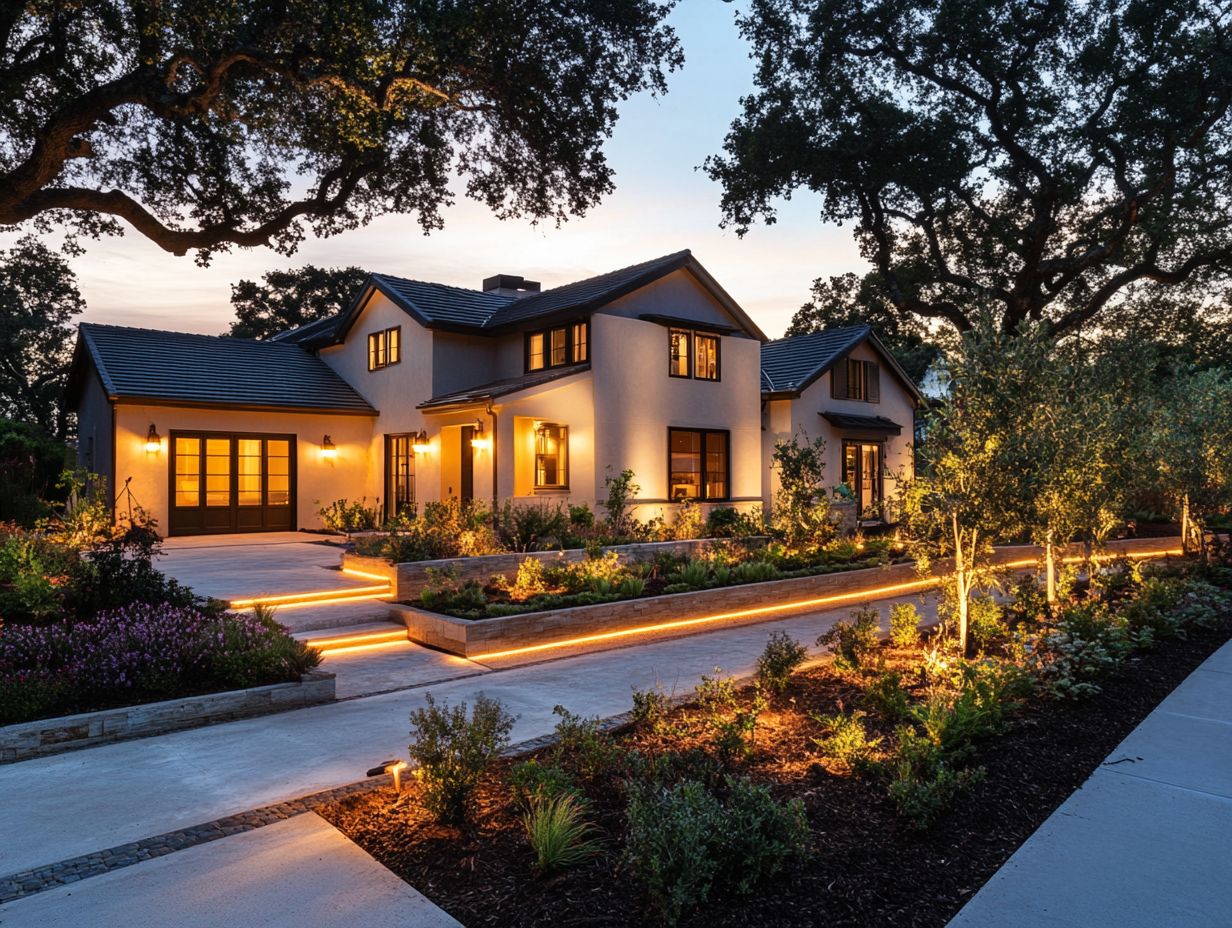Curb appeal is an essential aspect of real estate; it represents the first impression a home imparts to visitors and potential buyers.
An effective method to enhance this appeal is through strategic exterior lighting. The appropriate lighting can not only set the ambiance but also emphasize the architectural features of the home, thereby transforming the outdoor space.
This article examines the significance of exterior lighting, discusses the various types available, provides tips for designing an effective lighting plan, and outlines maintenance strategies—all while taking cost and energy efficiency into consideration.
Explore how thoughtful lighting techniques can elevate the charm and allure of your home.
The Importance of Curb Appeal

Curb appeal is a critical consideration for homeowners, as it has a substantial effect on the overall aesthetic of the property and can influence its value within the real estate market. By enhancing the exterior of a home through deliberate design choices, homeowners can create a welcome atmosphere that elevates neighborhood appeal and attracts potential buyers.
Key factors such as landscaping elements, exterior lighting, and decorative fixtures play a significant role in enhancing the charm and functionality of the property, resulting in an inviting space that highlights architectural features and reflects personal style.
Why Exterior Lighting Matters
Exterior lighting is essential for enhancing curb appeal, ensuring safety, and creating an inviting atmosphere in outdoor spaces. Thoughtfully designed outdoor illumination not only accentuates architectural features and landscaping elements but also guarantees visibility during nighttime for residents and visitors.
By employing various lighting types, such as pathway lights, accent lights, and flood lights, one can add depth and ambiance to the home’s exterior, while also fulfilling crucial functions like security lighting to deter potential threats and enhance nighttime visibility.
Incorporating motion sensor lights in high-risk areas enhances safety and promotes energy conservation by activating only when necessary. Strategically positioned uplights can create striking focal points by illuminating trees or sculptures, thereby elevating the overall aesthetic of the property.
Careful selections, such as warm white or cool white lighting tones, can evoke different moods, ensuring that outdoor gatherings exude a cozy or sophisticated atmosphere, depending on the occasion and desired lighting intensity.
Furthermore, investing in solar lighting options represents an eco-friendly strategy that offers sustainability while reducing electricity costs. Ultimately, a meticulously planned outdoor lighting scheme significantly contributes to both security and the creation of a welcoming, aesthetically pleasing environment.
Types of Exterior Lighting
Understanding the various types of exterior lighting is crucial for effective lighting design that enhances both the functionality and aesthetic appeal of outdoor spaces, as well as integrating design elements that reflect personal taste.
Options such as landscape lighting, architectural lighting, decorative outdoor fixtures, and lighting installation enable homeowners to tailor their lighting solutions according to personal style and property layout.
By carefully selecting appropriate fixture styles, including porch lights, flood lights, and garden lights, as well as downlighting, one can create a cohesive outdoor atmosphere that significantly enhances the curb appeal of a home.
Overview of Different Options

There is a wide array of options available for outdoor illumination, each providing distinct benefits and styles to accommodate diverse preferences and requirements.
A comprehensive understanding of the strengths and limitations of these lighting solutions is essential for creating an ideal atmosphere. For example, solar lights utilize sunlight to offer illumination without increasing electricity expenses; however, their brightness and effectiveness may vary based on weather conditions. In contrast, LED lights are renowned for their longevity and low energy consumption, making them an excellent choice for individuals seeking to minimize their carbon footprint.
Additionally, pathway lights enhance safety by illuminating dark outdoor areas, while accent lights can add a dramatic effect to gardens or patios, thereby enriching the overall ambiance. Each lighting option contributes to shaping the outdoor experience, addressing both aesthetic appeal and environmental considerations.
Designing Your Exterior Lighting Plan
Developing an effective exterior lighting plan requires meticulous consideration of various factors that impact the overall lighting design, functionality, and ambiance of outdoor spaces. This includes selecting appropriate illumination levels and fixture styles, as well as addressing the specific needs of the landscape.
Each aspect contributes to enhancing both the aesthetic appeal and safety of the home exterior. Additionally, themed lighting can establish a cohesive appearance that reflects personal style and complements the architectural features of the property.
Factors to Consider
Several critical factors must be taken into account when designing an exterior lighting scheme. These include optimal lighting placement, desired brightness levels, and the appropriate color temperature of the fixtures.
It is essential to select weather-resistant fixtures to ensure longevity and reliability, along with planning for ongoing maintenance to preserve the functionality and visual appeal of the lighting system. A comprehensive understanding of how these elements interact will facilitate the creation of a harmonious outdoor atmosphere that enhances the property’s curb appeal.
Incorporating layers of lighting—such as ambient, task, and accent—can significantly improve both functionality and overall aesthetics. Homeowners should remain aware of local regulations concerning lighting standards and consider the potential impacts on nighttime wildlife.
The use of timers or smart technology can also effectively manage energy consumption while providing flexibility in usage.
For practical implementation, it is advisable to begin with key areas such as pathways, patios, and entryways to ensure safety and usability. This approach can be gradually expanded to highlight landscaping and architectural features.
Installation and Maintenance

The proper installation and maintenance of an outdoor lighting system are essential for maximizing its effectiveness and longevity, thereby ensuring that the home remains well-illuminated and visually appealing.
Whether one opts for professional installation or pursues DIY lighting projects, a thorough understanding of the installation process and available smart lighting solutions is crucial for achieving optimal results.
Furthermore, regular maintenance is imperative to address any potential issues and to ensure that lighting fixtures operate at their peak performance, particularly given the increasing popularity of smart lighting solutions for modern homes.
Tips for Proper Installation and Care
To ensure a successful installation and maintenance of your outdoor lighting system, it is essential to select appropriate lighting solutions that align with the specific needs and aesthetic of your property. Attention should be given to fixture styles and seasonal lighting options that can adapt to changing outdoor decor, while also incorporating safety measures to protect both family and guests. Careful planning during outdoor renovations can significantly enhance the effectiveness of your lighting scheme and overall curb appeal.
Begin by evaluating specific areas that require illumination, such as pathways, decks, and garden borders, ensuring that each fixture not only fulfills a practical purpose but also complements the landscape design.
During installation, prioritize waterproof and weather-resistant models that are capable of withstanding seasonal changes, especially in regions that experience harsher climates, ensuring the longevity of the lighting fixtures.
Regular maintenance checks are imperative; fixtures should be cleaned periodically, and bulbs replaced as necessary to maintain optimal brightness and efficiency, especially with energy-saving bulbs.
Additionally, consider employing dimmers or timers and timer switches that provide adjustable lighting options, enabling you to set the desired mood for gatherings while ensuring safety after dark.
This comprehensive approach to outdoor lighting can transform your space, enhancing both functionality and visual appeal, while also improving outdoor entertaining opportunities.
Enhancing Curb Appeal with Lighting Techniques
Implementing effective lighting techniques can substantially enhance a home’s curb appeal by accentuating architectural features and fostering an inviting outdoor atmosphere for outdoor gatherings.
The use of strategic feature lighting, including spotlighting, not only directs attention to the property but also contributes to the overall ambiance, making outdoor spaces more conducive to entertaining and relaxation.
A well-designed lighting scheme has the potential to transform the exterior of a home, adding visual interest and elevating the overall aesthetic experience, contributing to the neighborhood charm.
Using Lighting to Highlight Features

Utilizing lighting strategically to highlight the features of a property can significantly transform the visual appeal of outdoor spaces and improve driveway design. Feature lighting can be employed to illuminate architectural elements, trees, or garden features, ensuring they are prominently showcased at night. By thoughtfully positioning lights, one can create focal points that draw attention and accentuate the unique characteristics of the home’s exterior.
Incorporating techniques such as wall washing or spotlighting can effectively enhance the allure of walkways or water features. The selection of warm-toned lights can foster an inviting atmosphere, while brighter options may serve to improve safety and visibility.
Layering various types of lighting, including path lights, sconces, and uplights, can create a dynamic interplay that guides guests through the landscape. Directing lights at attractive trees or distinctive garden sculptures not only emphasizes their beauty but also adds depth to the nighttime scene, inviting admiration and enhancing the overall ambiance of the property.
Creating Ambiance and Atmosphere
The appropriate lighting can significantly enhance the ambiance and atmosphere of outdoor spaces, transforming them into welcoming areas for entertaining and relaxation. By employing mood-setting techniques, such as implementing color schemes and varying light intensities, one can create an atmosphere that aligns with personal preferences. This meticulous approach to lighting design can greatly enhance the enjoyment of outdoor living areas while simultaneously improving curb appeal.
To truly elevate the experience, it is advisable to incorporate soft, warm hues that evoke a cozy atmosphere during intimate gatherings, while cooler tones can foster a refreshing environment for more lively events. Varying brightness levels contributes to versatility; dimming lighting facilitates calm conversations, whereas brighter settings are ideal for social interaction.
Additionally, accent lighting should not be overlooked, as it adds depth and interest to landscaping features, ensuring that every corner of the outdoor space is visually appealing. By employing these thoughtful lighting techniques, each outdoor event can become a memorable occasion, encouraging friends and family to linger longer under the stars.
Cost and Energy Efficiency
Understanding the cost implications and energy efficiency of exterior lighting choices is essential for homeowners aiming to maximize their investment while minimizing long-term expenses.
By exploring budget-friendly options and energy-saving strategies, individuals can select lighting solutions that align with both their financial and environmental objectives.
Furthermore, smart lighting technology presents innovative methods for managing energy consumption, offering increased flexibility and control over outdoor illumination.
Budget-friendly Options and Energy-saving Tips
When seeking budget-friendly options for outdoor lighting, it is advisable to consider solar lights and energy-efficient LED lights. These solutions provide long-term savings and require minimal maintenance. They not only reduce energy consumption but also offer versatility and ease of installation for various outdoor applications.
Implementing energy-saving strategies can further enhance the efficiency of your lighting system, ensuring optimal performance while remaining within budgetary constraints.
Exploring features such as motion sensors and timers can significantly diminish unnecessary energy usage, enabling homeowners to benefit from well-lit environments without incurring excessive energy costs.
Selecting solar lights allows individuals to harness solar energy, which is both environmentally sustainable and reduces dependence on conventional energy sources. In addition, LED lights, recognized for their durability and brightness, present a variety of styles to complement any aesthetic preference.
By opting for these budget-conscious and sustainable alternatives, individuals can effectively transform their outdoor spaces while being mindful of both financial considerations and environmental impact.